In my last post I offered some impressions and understandings of the Irish landscape and some of the flowering plants we enjoyed. Here I am concluding this two part series by introducing some of the animals we encountered. There's nothing unexpected here and if you're familiar with Ireland (or indeed other parts of Europe) then you may well find this a bit pedestrian. But if, like us, you're not sure what to expect there then you may find it of interest. There are quite a few birds in particular so it's a relatively long post, but I'll try to keep it manageable by mostly making it a photo essay without too much other commentary.
I'll start with a few other animals. We didn't do well with mammals; I expected to see Red Deer in the moorlands, and really hoped to see a Stoat (which are apparently commoner there than in Britain) but we missed on both. Others told us about Basking Sharks close to the shore, but again no luck. Here are a couple of nice ones that we did see however.
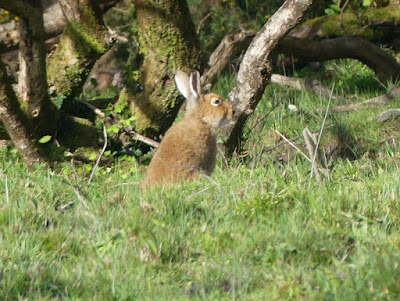 |
Irish Hare Lepus timidus, Iveragh Peninsula, County Kerry.
This is the Irish subspecies of Mountain Hare, which is found right across far northern
Europe and Asia, plus the European Alps and the Scottish highlands. This rusty coat
is typical of it; we didn't see it often and this is the only photo I managed. |
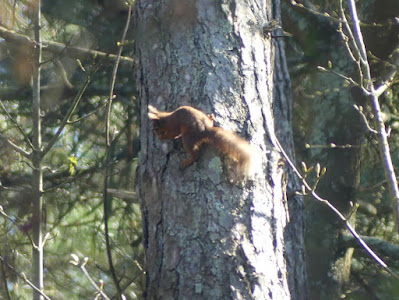 |
Distant Red Squirrel Sciurus vulgaris, The Raven NR, County Wexford.
This squirrel is found across Eurasia from Portugal to the Bering Strait but in Britain
in particular it has declined severely from competition by the introduced North American
Grey Squirrel Sciurus carolinensis. In Ireland however Red Squirrels are doing fairly well
following their almost total extinction due to the completion of deforestation
in the 17th century and reintroductions in the 19th century. So far Grey Squirrels have
not appeared in the west of Ireland - perhaps they are still unaccustomed to being
hunted by Pine Martens, while the Reds have developed protective strategies?
- but elsewhere they carry diseases which do affect Red Squirrel populations. |
 |
Grey Seal Halichoerus grypus, Great Saltee Island, Co Wexford.
We surprisingly didn't see many seals (and no Harbour Seals); a boat trip we
did in Donegal Harbour to visit a colony was nowhere near as interested
in them as we were, despite their advertising. |
I recall my astonishment when our good friend Sarah, from England, told us long ago that there is only one frog native to Britain - The Frog! We were delighted to have Sarah and Richard with us for a couple of days in Wexford and she found a frog for us at Tacumshin Wetland (more on that, and other reserves mentioned here, in the previous post - see link in first line above).
 |
| Common Frog (to give it its full name!) Rana temporaria, Tacumshin Wetland. |
 |
This extremely impressive big Black Slug (or Black Arion) Arion ater
appeared on our cabin verandah after a wet night near Doolin, Co Clare.
It's normally nocturnal but this was a dull morning. It's native to northern Europe
but has been introduced elsewhere, apparently including Australia though
I've not seen one here. They grow to 15cm long so are hard to miss! |
It was early spring while we were there and the flowers were appearing, though many hadn't started by the time we left in early May. There were quite a few small quick grey butterflies, but one stood out, though we didn't get very close to it.
 |
This Peacock Butterfly Aglais io, The Raven NR, Co Wexford, is truly lovely.
They hibernate over winter to give their larvae a head-start in spring, hence
this one being active so early. |
The insects we saw most on flowers however were bumblebees, which I was intrigued by as there are none native to Australia and they really are very appealing. To my surprise when I got back and did some homework I realised that I had photos of four different species, though as ever I welcome corrections.
 |
| White-Tailed Bumblebee Bombus lucorum, Glenveagh NP, Co Donegal. |
 |
| Garden Bumblebee Bombus hortorum, Glenveagh NP, Co Donegal. |
 |
| Common Carder Bee Bombus pascuorum on Dandelion, Wild Nephin NP, Co Mayo. |
 |
Buff-Tailed Bumblebee Bombus terrestris, on Thrift flowers, Fanad Lighthouse, Co Donegal.
This one I'm not entirely confident about as I can't see its tail, but the orange band
(rather than yellow) encourages me. |
Which brings us to the birds. Again if you're familiar with European birds there won't be much to excite you here but hopefully it's of some interest to other readers. Our first real excursion after we left Dublin was a very good one, via a ferry to Great Saltee Island off Wexford, accompanied by our very bird-wise friends, Richard and Sarah Thomas. It gave us by far the best seabird experience of our month in Ireland (which was probably a mixed blessing, having it over with right at the start!), and also coincided with a wonderful 'fall' of migrant songbirds coming north from Africa en route either to Ireland itself or points much further north for summer. Let's start with the seabirds though, where several species were already breeding - and we might as well start with the stars (as voted by us), the Atlantic Puffins
Fratercula arctica which must be one of the most-recognised birds in the western world! We had the bizarre and delightful experience of sitting down on a grassy slope to eat our picnic lunch while less than 20 metres away puffins loafed and paraded by their burrows. They get two photos!
 |
Atlantic Puffins (there are also two species from the North Pacific)
by their breeding burrows, Great Saltee Island, Co Wexford. Males and females
are indistinguishable (to us anyway). They are auks (not to be confused with orcs),
a family of northern hemisphere seabirds. |
 |
The extraordinary bill only looks like this during breeding; afterward the bright
orange plates are shed and the bill is much plainer, though as they spend winter
entirely at sea we rarely it like that. The structure of the bill enables them to carry up to a
dozen sand eels at a time, which they've caught underwater, to the nest.
(The first ones are held in place by the tongue, while they catch more.) |
OK, so puffins also get more words here than most other birds are going to; favouritism? Yeah, guilty as charged. Another two auk species were also present, probably more abundant here than the puffins. I couldn't get close enough to the Common Guillemots (or Murres)
Uria aalge for a photograph, but the abundant Razorbills
Alca torda were more obliging. Unlike the puffins on Great Saltee, both these species nest on the cliff faces.
 |
Razorbills, Great Saltee. The white line on the bill is only present during breeding.
The somewhat similar guillemots have a sharp, thin bill, rather than the Razorbill's
side-to-side flattened deep bill. |
Australia is quite depauperate in gull species relative to other places, with only three regular species. The Saltee cliffs alone had more species than that. Here are three of them.
 |
Lesser Black-backed Gull Larus fuscus, Great Saltee. There were also
Great Black-backed Gulls present, which are the world's largest, but I somehow
failed to get a photo of them. |
 |
Kittiwakes Rissa tridactyla, Great Saltee. This is an elegant little gull, and the only
one which nests solely on cliffs. |
 |
Herring Gulls Larus argentatus were also at Great Saltee (indeed they seem to be
absolutely everywhere) but these were in Dublin. In fact they were the first Irish
birds we saw, flying overhead as we rode in a taxi from the airport to our hotel.
This is an enormous gull, at least four times the weight of our familiar Silver Gull. |
Another very common gull across Ireland is the Black-headed Gull
Chroicocephalus ridibundus, another small gull. This one was hunting crabs (successfully) alongside the ruined Doe Castle in Donegal.

And here are another two common seabirds which were nesting on the Great Saltee cliffs.
 |
A nesting colony of Northern Gannets Morus bassanus, on a rock stack just
off Great Saltee. This is the largest gannet species in the world. Although
numbers are currently healthy there is concern about their vulnerability to bird flu. |
 |
Gannets hunt by diving from considerable heights into the ocean and chasing
fish underwater. This one off County Galway was just starting its dive. |
 |
Shag Gulosus aristotelis on Great Saltee where there was a small breeding group.
This is a common marine cormorant, but the cormorant which can be seen anywhere
throughout Ireland is the same as our Great Cormorant Phalacrocorax carbo. |
 |
Common Shelduck Tadorna tadorna, on tidal flats of the Moy River, Co Mayo.
This is a very handsome big duck which I found hard to get near. It is nearly
always found on estuaries and salt marshes. |
 |
Greylag Geese Anser anser, in a bay near Carrowkeel, Co Donegal.
These are the ancestors of domestic geese, and are more usually seen on inland waters
and fields. They're mostly winter vistors to Ireland but some stay all year round. | |
There are of course other waterbirds which can be found on both inland and coastal waters too, including the ubiquitous Grey Heron Ardea cinerea.
 |
| Grey Heron in a freshwater pond, St Stephens Park, Dublin... |
 |
| ... and in a bay, Co Donegal. |
And for the record, a couple of the commonest waterbirds in Ireland, found on any inland waters, including town parks. Both these photos were taken in Saint Stephens Park, Dublin.
 |
Mallard Anas platyrhynchos, the basis of all domestic ducks except Muscovies
(which are from South America). In the same way as we had to get used to seeing
Gorse and Hawthorn as native species rather than weeds, it took a bit to get thinking
of Mallards as other than exotics. |
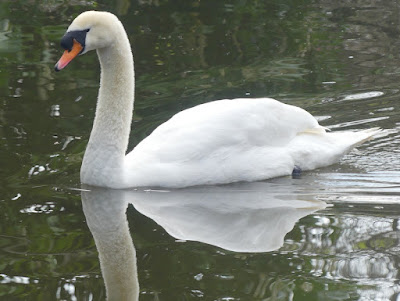 |
Mute Swans were abundant on rivers, loughs, and town parks,
and are always superb birds. |
And so to some land birds, perhaps the most obvious of which were the various species of crows which were virtually never out of sight. Here are four common ones, plus another couple which we only encountered once.
 |
Rook Corvus frugilegus inspecting the picnic tables at The Hook lighthouse, Co Wexford.
This is a large sociable crow which feeds in flocks and is found across Eurasia; the broad
expanses of cleared Irish countryside suit it well. It is readily distinguished by the large bare
white patch of skin around the base of the beak. |
 |
Rooks also breed colonially; here is an active spring rookery in Co Tipperary.
This is a common sight across Ireland. |
 |
Eurasian Magpie Pica pica, Dublin. The origin of the (unrelated) Australian Magpie's name.
Highly intelligent and found throughout Ireland - and east to Kamchatka. |
 |
Jackdaw Coloeus monedula, Cashel Castle, Co Tipperary. An engaging little gregarious crow
which is abundant in Ireland, and often nests in the rnassive stone ruins which dot the countryside. |
 |
Hooded Crow Corvus cornix, Doolin, Co Clare. A striking crow (especially to those of us
who expect all crows to be black!) which I found to be particularly wary, probably with
good reason. An inveterate scavenger, it is found in all habitats from the sea shore to the mountains. |
 |
Red-billed Chough Pyrrhocorax pyrrhocorax, Great Saltee Island. An uncommon crow
of the Atlantic cliffs and islands of Ireland, we were very fortunate to see this bird (and its mate)
at the beginning of our trip at Great Saltee, as we didn't see it again. No relation to
(and really very little resemblance to) its Australian namesake the White-winged Chough. |
 |
(Eurasian) Jay Garrulus glandarius, Belleek Woods, Co Mayo. A very poor photo of
this attractive forest crow, but surprisingly it was the only one we saw. My ignorance of the
calls of the Irish birds probably contributed to this, but they are also reported to be
'significantly shyer and more elusive' in Ireland than they are elsewhere in Europe. |
Finches are always welcome, not least because we don't have any native 'real' finches in Australia; the birds we refer to as finches all belong to another family entirely, the grassfinches or waxbills. Nonetheless we continue to call ours finches and that's fine, but here are the 'other finches' if you'd prefer.
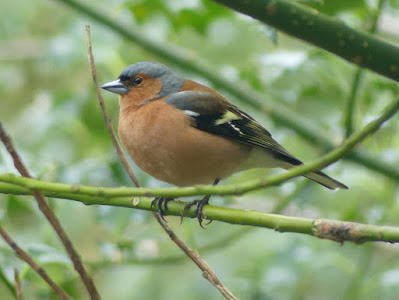 |
Male Chaffinch Fringilla coelebs, Glenveagh NP, Co Donegal.
One of the commonest birds in Ireland, and always a delight. |
 |
Female Chaffinch, Co Cork. They are essentially seed-eaters like all finches
(and indeed all grassfinches). |
 |
Bullfinch Pyrrhula pyrrhula, Co Clare. A very poor photo of a most attractive
bird, but sadly it was the only one I got. |
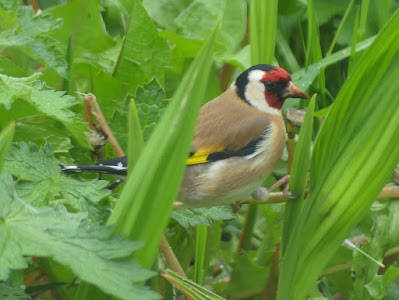 |
Goldfinch Carduelis carduelis, just outside our cabin window near Lough Gill, Co Sligo.
This one has been familiar to Australians since its introduction here in the 19th century,
but it's never been in sufficient numbers here to cause concern. |
 |
Siskin Spinus spinus, seen through the same window. This one is common enough,
though we didn't see it as often as the Goldfinch, or perhaps it just doesn't stand out
as much when seen from a car window. |
Thrushes are prevalent, but mostly the three following common species; we saw others, but no photos.
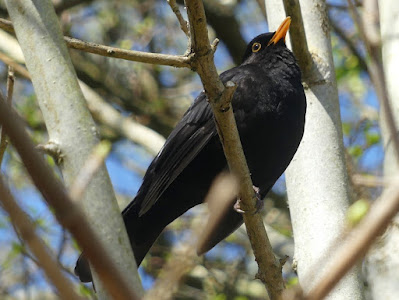 |
Common Blackbird Turdus merula, Dublin. This is a familiar exotic species in
south-eastern Australian urban areas and, as with other such species, it was
good to be able to enjoy it as a native species on its home turf. |
 |
Song Thrush Turdus philomelos, County Kerry. One of the commonest Irish birds,
usually seen hunting worms and insects on grassy areas. Though they were released in
Australia in the 19th century by the pernicious acclimatisation societies, the introductions
were not ultimately successful and now they survive only as a small and declining
population in Melbourne and on Lord Howe and Norfolk Islands. |
 |
Mistle Thrush Turdus viscivorus, Belleek Woods, Co Mayo. Another fairly common
thrush, often feeding in the open like the Song Thrush. This one was very curious,
inspecting us from various angles as soon as we stepped out into the carpark. |
Here are a couple of Old World flycatchers (ie members of the big family Muscicapidae), one of which is probably the bird most featured on Christmas cards, albeit usually in distortion and in countries, such as Australia, very far from where it actually lives.
 |
European Robin Erithacus rubecula, Co Donegal. It actually could have been
taken anywhere, as they are ubiquitous, in town and forest, and are curious and engaging,
often accompanying gardeners to see what's turned up that might be wriggling and edible. |
 |
Male Northern Wheatear Oenanthe oenanthe, Great Saltee Island, Co Wexford.
This bird had just flown in, with many others of various species, from somewhere
in Africa where it had spent winter, to breed in Irish heathlands in mountains
or along rocky coasts. |
Wagtails and pipits (same family) are abundant, though this is only true of one or two species of each.
 |
Pied Wagtails Motacilla alba are seemingly everywhere in open spaces, on grass or
even carparks and other sealed urban space, or along the coast. They hunt insects on the ground.
Both these birds were in County Cork, the male above in the grounds of one of the
numerous castles, ruined and otherwise; most castles have a resident pair.
He is in his dapper summer plumage. |
 |
This one, on the busy foreshore in Cobh is, I'm pretty sure, a female, though
I have some trouble with recognising males coming out of their paler winter coat. |
 |
Distant Grey Wagtail Motacilla cinerea on the mud flats of the River Ilen in Skibereen,
also in Co Cork. It is apparently 'common and widespread' but I mostly missed them!
We probably didn't spend enough times along rushing streams. |
The two resident species of pipits are both common, though one is found only along the coast.
 |
Meadow Pipit Anthus pratensis, Co Clare. It is found throughout the island in open country,
(of which there is a lot), but I found them hard to approach closely. |
 |
Rock Pipits A. petrosus, here on shoreline rocks in Co Kerry, are birds of the shorelines
and offshore islands. It seemed to me to be a lot more tolerant of humans than Meadow Pipits. |
The 'Old World Warblers' used to form a huge family of small songbirds, but better understanding has now recognised that this was always just a grouping of convenience and several families are actually involved. Many of these warblers pass through Ireland from their wintering grounds in Africa, but here are a couple that breed in Ireland and are quite common.
 |
| Blackcap Sylvia atricapilla, Family Sylviidae, Co Wexford. A very distinctive bird. |
 |
Less distinctive for newcomers like me to the European birds, is the
Willow Warbler Phylloscopus trochilus, here singing in Killarney NP, Co Kerry.
It is very similar to the closely related Chiffchaff P. collybita, but the songs are different
and the yellow legs on this bird are very different from the black ones of Chiffchaffs. |
There are three very common species of tit, Family Paridae, which are also widely familiar as they readily come to garden feeders. Here are two of them.
 |
Blue Tit Parus caeruleus Co Cork; this is likely to be one of the first Irish birds you see,
and they are colourful, abundant and not especially shy. I find them most endearing. |
 |
Great Tits Parus major Co Sligo. This very much seems to be ritual courtship
feeding, as the adult recipient certainly doesn't need to be fed in this situation! |
And finally four birds from four families, all fairly common, one abundant.
 |
Wood Pigeon Columba palumbus, Dublin. Another of the very commonest Irish
birds, in towns and countryside. There is open hunting season on them over the three winter
months (November to January) when they are not breeding, but there are also huge loopholes
which allow shooting pretty much all year round, and it seems to be quite an industry, eg here.
Needless to say, Wood Pigeons in rural areas are pretty toey! |
 |
Reed Bunting Emberiza schoeniclus, Co Wexford. This attractive bunting is certainly a bird of
the reed beds, but is also found beyond them. It has a huge range over most of Europe
and much of Asia. |
 |
Dunnock Prunella modularis, Glendalough, Co Wickford. An easily overlooked
little bird of the forest understorey, hedgerows and even in town parks, though I
certainly overlooked them there! They are accentors, in the Family Prunellidae,
of which there are only a dozen closely related species, nearly all the others
being birds found very high in the mountains, above the tree level. |
 |
And lastly one of my favourites (yes I know but I can't help it), the tiny
Goldcrest Regulus regulus, here preening in early dawn light outside our
cabin in rural Co Kerry. You can just see the yellow and orange crest here,
but better below in an even more light-deprived photo, which makes this a male.
(She has just yellow.) Its family, the kinglets, has just six members
across Eurasia and North America. |
Well I hate to leave you with such a poor photo, which hopefully you can forgive me for the sake of the subject.
It's been a long post, as I warned, and if you've got this far I thank you for your diligence!
THERE WILL BE QUITE A HIATUS NOW BEFORE MY NEXT POST,
AS WE'LL BE TRAVELING TO AND IN TROPICAL QUEENSLAND.
HOWEVER I SHOULD COME BACK WITH MORE MATERIAL FOR YOU!
NEXT POSTING THURSDAY 18 SEPTEMBER
I
love to receive your comments and in future will be notifying you
personally by email when a new posting appears, if you'd like me to. All
current subscribers have been added to this mailing list and have
already been contacted. This will mean one email every three weeks at the current rate of posting. I promise never to use the list for any other purpose and will never share it.
Should you wish to be added to it, just send me an email at calochilus51@internode.on.net. You can ask to be removed from the list at any time,or could simply mark an email as Spam, so you won't see future ones.
If you do leave a comment - and I love it when you do - please remember to click the
box below your comment that says 'Email follow-up comments to...[your address]'
so you'll know when I reply - and I always do!

























































